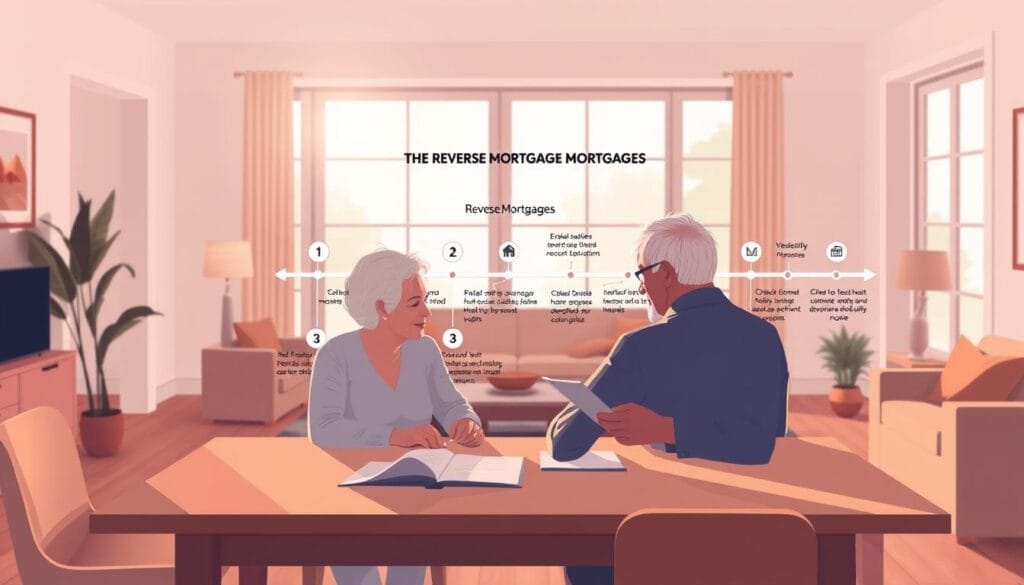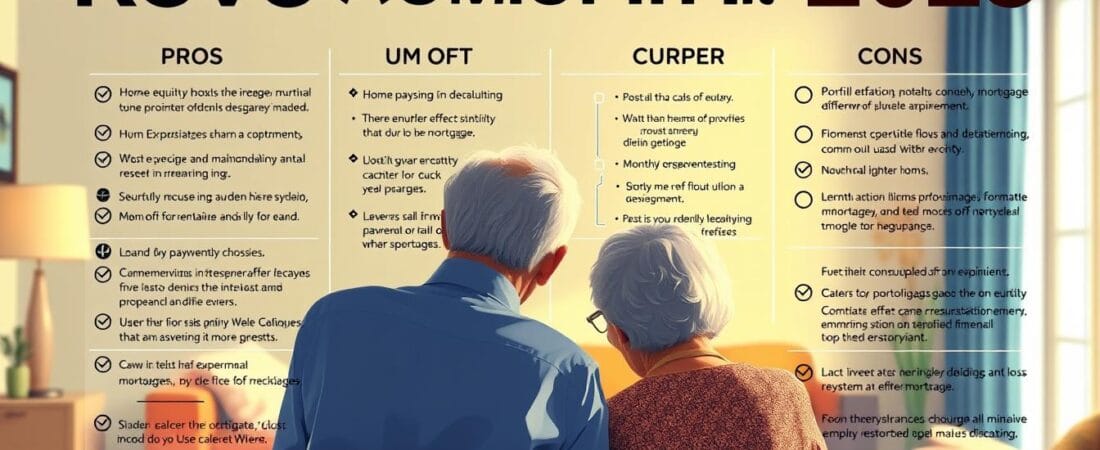Did you know that over 1 million homeowners in the U.S. have used a reverse mortgage to access their home equity? This financial tool, designed for individuals aged 62 and older, allows homeowners to convert their property’s value into tax-free income while retaining ownership. As we approach 2025, understanding its implications is more critical than ever.
With evolving regulations and shifting housing market trends, this option presents both opportunities and challenges. It can supplement retirement income, but it also raises concerns about inheritance and long-term financial planning. Factors like age, home equity, health, and estate goals play a significant role in determining its suitability.
For those unsure about this path, alternatives like HELOCs or downsizing may offer viable solutions. This article provides an objective analysis to help you decide if a reverse mortgage aligns with your financial goals for 2025.
Key Takeaways
- Reverse mortgages are available to homeowners aged 62 and older.
- They provide tax-free income while allowing you to keep your home.
- 2025 brings new regulations and housing market trends to consider.
- Key factors include age, home equity, health, and estate planning.
- Alternatives like HELOCs or downsizing may be worth exploring.
Introduction to Reverse Mortgages

For many seniors, converting home equity into cash can be a financial lifeline. A reverse mortgage is a loan that allows homeowners aged 62 and older to access their property’s value without selling it. Unlike traditional mortgages, this option doesn’t require monthly payments. Instead, the loan balance is repaid when the homeowner moves out, sells the property, or passes away.
To qualify, you must be at least 62 years old (55 in some states) and use the home as your primary residence. Additionally, you’re required to maintain homeowners insurance and pay property taxes. These conditions ensure the property remains in good standing throughout the loan term.
Starting in 2025, the Federal Housing Administration (FHA) will increase lending limits for reverse mortgages. Enhanced spousal protections will also be introduced, providing greater security for surviving partners. These updates aim to make the process more accessible and safer for borrowers.
However, it’s crucial to approach this option with caution. TV marketing often oversimplifies the benefits, leaving out important details. Conducting thorough research and consulting a financial advisor can help you make an informed decision. Understanding the home equity conversion process is key to determining if it aligns with your financial goals.
Understanding the Basics of Reverse Mortgages

Understanding the mechanics of home equity conversion is essential for informed decision-making. This financial tool allows homeowners to access their property’s value without selling it. However, it’s important to break down the loan structures and long-term obligations involved.
There are two primary types of reverse mortgages: HECM (Home Equity Conversion Mortgage) and proprietary/jumbo loans. HECM is federally insured and more common, while proprietary options cater to higher-value properties. Each has unique terms and eligibility requirements.
Borrowers can choose how to receive funds: as a lump sum, a line of credit, or monthly payments. Each option has its advantages, depending on your financial needs. For example, a line of credit offers flexibility, while monthly payments provide steady income.
Interest on these loans accrues over time, compounding the loan balance. This means the amount owed increases significantly over the years. Borrowers must also meet ongoing responsibilities, such as paying property taxes, maintaining homeowners insurance, and keeping the property in good condition.
Starting in 2025, new appraisal standards will impact how property values are assessed. Estated.com estimates will be compared to HUD-required valuations, ensuring accuracy and fairness. These changes aim to protect borrowers and lenders alike.
Non-borrowing spouses must also adhere to occupancy and maintenance rules to remain eligible. Additionally, an upfront mortgage insurance premium of 2% of the property value is required. These factors highlight the importance of careful planning and consultation with a financial advisor.
Pros of a Reverse Mortgage

Exploring the benefits of accessing home equity can provide financial flexibility for seniors. This financial tool offers several advantages, including tax-free income, the ability to stay in your home, and protection against negative equity. Understanding these benefits can help you determine if it’s the right choice for your financial goals.
Tax-Free Income
One of the most significant advantages is the ability to receive funds without tax implications. This can be a lifeline for seniors looking to supplement their retirement income. Whether taken as a lump sum, monthly payments, or a line of credit, the funds remain tax-free.
Stay in Your Home
Homeowners can continue living in their property while accessing its equity. This is particularly beneficial for those who want to age in place. As long as you meet the loan requirements, such as maintaining homeowners insurance and paying property taxes, you retain ownership.
Non-Recourse Loan Protection
This financial tool offers protection against negative equity. If the home value declines, lenders cannot claim other assets to cover the loan balance. This safeguard ensures that neither borrowers nor their heirs are burdened with additional debt.
Starting in 2025, FHA insurance will cover up to 95% of the appraised value, further reducing risks. This update provides additional security for borrowers, making it a more attractive option. For more details, review our terms and conditions.
Cons of a Reverse Mortgage

While accessing home equity can be beneficial, it’s essential to weigh the potential drawbacks. This financial tool comes with significant costs and responsibilities that may not suit everyone. Understanding these challenges can help you make an informed decision.
High Upfront Costs
One of the primary concerns is the expenses associated with initiating this loan. Borrowers must pay an upfront mortgage insurance premium, origination fees, and closing costs. These charges can total thousands of dollars, reducing the net amount available for use.
Impact on Heirs
This financial arrangement can also affect your heirs. The loan balance must be repaid when the homeowner passes away, which may require selling the property. This could limit the inheritance left for your family, especially if the home’s value has declined.
Ongoing Financial Responsibilities
Borrowers are required to maintain the property and cover ongoing costs like property taxes and insurance. Neglecting these responsibilities can lead to foreclosure. For example, failing to repair a damaged roof or HVAC system can result in significant penalties.
Retirees on fixed incomes should carefully budget for these expenses. Tools like a budget template can help manage these costs effectively. Proper planning ensures you avoid defaulting on essential obligations.
Is a Reverse Mortgage Right for You?

Deciding whether this financial tool aligns with your goals requires careful evaluation. Ideal candidates are typically long-term homeowners with over 50% equity in their property. This ensures sufficient funds are available to meet financial needs while minimizing risks.
To determine if this option suits your situation, consider these five key questions:
– Are you at least 62 years old?
– Do you plan to stay in your home long-term?
– What is your health prognosis?
– How much equity do you have in your property?
– Are you prepared for the ongoing financial responsibilities?
Starting in 2025, rising interest rates may extend the break-even timeline for this financial tool. This means it could take longer to recoup the upfront costs, making it less appealing for some borrowers. Evaluating these factors is crucial to making an informed decision.
For visual learners, an alternatives assessment flowchart can simplify the decision-making process. This tool helps compare options like downsizing or using a micro-investing platform to determine the best fit for your financial goals.
Ultimately, this financial tool can provide valuable income during retirement, but it’s not a one-size-fits-all solution. Consulting a financial advisor and conducting thorough research are essential steps to ensure it aligns with your long-term plans.
Alternatives to a Reverse Mortgage

Exploring other financial strategies can provide seniors with flexibility and security. While accessing home equity is one option, there are several alternatives worth considering. These solutions can help you achieve your financial goals without the potential drawbacks of a traditional approach.
Home Equity Loans and HELOCs
Home equity loans (HELOCs) allow homeowners to borrow against their home equity while retaining ownership. Unlike other options, these loans require monthly payments, but they offer lower interest rates and predictable terms. This can be a viable solution for those who need funds for specific expenses, such as home improvements or medical bills.
HELOCs provide a revolving line of credit, giving you access to funds as needed. This flexibility makes them ideal for managing unexpected costs or supplementing retirement income. However, it’s essential to budget carefully to avoid overextending your finances.
Selling Your Home
Downsizing to a smaller home can free up equity and reduce living expenses. This option is particularly appealing for those who no longer need a large property. Selling your home allows you to access a lump sum of cash, which can be used to fund your retirement or other financial goals.
Moving to a more affordable area can also lower your cost of living. This strategy can provide long-term financial stability, especially if you’re on a fixed income. It’s a practical way to maximize your savings and simplify your lifestyle.
Other Financial Resources
For seniors seeking additional income, part-time work is a popular choice. According to recent data, 34% of seniors use part-time jobs to supplement their finances. This can be a rewarding way to stay active while boosting your cash flow.
Other options include Medicaid-compliant annuities for long-term care funding and state-specific property tax deferral programs. These resources can provide financial relief and help you manage expenses more effectively.
For more information on managing your finances, explore our guide on home equity loans (HELOCs). This resource offers valuable insights into making informed financial decisions.
Reverse Mortgage Requirements

Meeting the criteria for a reverse mortgage involves several key requirements. These ensure that borrowers are well-informed and prepared for the financial commitment. Understanding these prerequisites is essential for a smooth application process.
One mandatory step is HUD counseling, which costs between $125 and $250. This session educates borrowers about the loan’s terms, risks, and alternatives. It’s designed to protect seniors from making uninformed decisions.
Starting in 2025, the FHA lending limit for single-family homes will increase to $1.089 million. This change reflects rising property values and aims to make the loan more accessible to homeowners with higher equity.
Credit requirements also play a role. Borrowers with scores below 620 may need a “Life Expectancy Set-Aside.” This ensures funds are reserved for future expenses, reducing the risk of default.
Property inspections are another critical requirement. Lenders assess the roof’s lifespan, HVAC condition, and overall maintenance. These checks ensure the property remains in good condition throughout the loan term.
By meeting these requirements, borrowers can confidently proceed with their application. Thorough preparation and understanding of the process are key to a successful experience.
Financial Planning with a Reverse Mortgage
Strategic financial planning can significantly enhance the benefits of accessing home equity. For seniors, understanding how to manage funds effectively ensures long-term sustainability and maximizes the value of their assets.
One key strategy is strategic disbursement. By keeping income below taxable thresholds, seniors can preserve Social Security benefits. Funds from a line of credit are not considered taxable income, making this approach highly effective.
Another valuable tool is Monte Carlo simulations. These models project financial scenarios over 30 years, helping retirees assess the sustainability of their plans. For example, they can determine if a line of credit will meet future needs or if adjustments are necessary.
Coordination with Medicaid and VA pension rules is also critical. Seniors must ensure that accessing home equity doesn’t disqualify them from these benefits. Proper planning can help balance retirement income with eligibility requirements.
The line of credit grows at 1.5x the interest rate, providing flexibility for strategic financial planning. This compounding growth allows seniors to access more funds over time without immediate tax implications. For more insights, explore our guide on financial planning strategies.
By integrating these strategies, seniors can make informed decisions that align with their retirement goals. Proper planning ensures that accessing home equity enhances financial security rather than creating new challenges.
Risks and Safeguards
Navigating the complexities of financial tools requires awareness of potential risks and safeguards. Understanding these aspects ensures that borrowers and their families are protected throughout the process. This section explores key measures to mitigate risks and enhance security.
Protecting Against Exploitation
One of the primary concerns is the risk of exploitation, especially for seniors. Scammers often target vulnerable individuals with misleading offers. To safeguard against this, borrowers should work with reputable lenders and seek independent financial advice.
Additionally, mandatory HUD counseling ensures that borrowers fully understand the terms and implications of the loan. This session educates them about potential risks and alternatives, empowering them to make informed decisions.
Understanding Spousal Protections
Spousal protections are crucial for ensuring the security of non-borrowing partners. Starting in 2025, extended deferral periods will provide surviving spouses more time to adjust after the borrower’s passing. This update aims to reduce financial stress during a difficult time.
Non-borrowing spouses must be listed on the title to qualify for these protections. They are also required to maintain the home as their primary residence and fulfill ongoing financial obligations. These measures ensure that the property remains secure and the loan terms are upheld.
For more detailed information on spousal protections, consult our comprehensive guide. This resource provides valuable insights into safeguarding your family’s financial future.
Conclusion
Evaluating financial options for retirement requires a clear understanding of long-term goals. This financial tool is best suited for long-term homeowners who need liquidity and plan to stay in their homes for an extended period. Short-term use cases, such as less than five years, may not justify the associated costs and fees.
While this option offers flexibility, it’s essential to weigh the pros and cons carefully. High upfront expenses and ongoing responsibilities like property taxes and insurance must be factored into your decision. For those unsure about its suitability, tools like the ARLO™ calculator can provide personalized analysis.
Ultimately, this financial strategy can be a valuable resource for seniors seeking to enhance their retirement income. However, thorough research and consultation with a financial advisor are crucial to ensure it aligns with your unique needs and goals.

